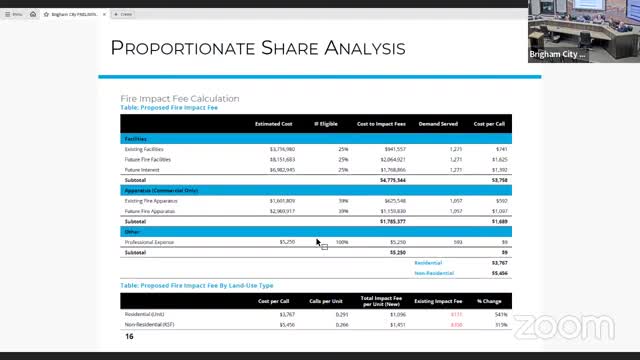City plans $10 million fire facility amid space crisis
October 18, 2024 | Brigham City Council, Brigham City, Box Elder County, Utah
This article was created by AI summarizing key points discussed. AI makes mistakes, so for full details and context, please refer to the video of the full meeting. Please report any errors so we can fix them. Report an error »

During a recent government meeting, officials discussed the capital facilities plan for a new fire training facility, which is projected to cost just over $10 million. A significant portion of this cost, approximately 81%, could potentially be covered by new development through impact fees. However, if these fees are not implemented, the financial burden would fall entirely on existing residents, leading to increased tax payments.
The conversation highlighted the importance of determining the necessity of new facilities, particularly in light of the city's growing population and the current overcrowding in municipal offices. Officials noted that the existing city hall, built in 1972, is operating at full capacity, with multiple staff members sharing offices. This situation raises concerns about the adequacy of space for essential services, including police and fire departments.
Council members emphasized the need for a comprehensive assessment of future demands on city services, particularly as the population is expected to grow beyond the current estimate of 21,000 by 2035. They acknowledged that previous impact fees have not included provisions for new fire or police stations, which could lead to challenges in meeting service demands as the city expands.
The discussion also touched on the historical context of impact fees in Utah, which have been in place since 1996. Officials expressed the need for a balanced approach to funding new facilities, ensuring that costs are equitably distributed among current and future residents. The meeting underscored the urgency of addressing these infrastructure needs to avoid placing undue financial strain on the community.
The conversation highlighted the importance of determining the necessity of new facilities, particularly in light of the city's growing population and the current overcrowding in municipal offices. Officials noted that the existing city hall, built in 1972, is operating at full capacity, with multiple staff members sharing offices. This situation raises concerns about the adequacy of space for essential services, including police and fire departments.
Council members emphasized the need for a comprehensive assessment of future demands on city services, particularly as the population is expected to grow beyond the current estimate of 21,000 by 2035. They acknowledged that previous impact fees have not included provisions for new fire or police stations, which could lead to challenges in meeting service demands as the city expands.
The discussion also touched on the historical context of impact fees in Utah, which have been in place since 1996. Officials expressed the need for a balanced approach to funding new facilities, ensuring that costs are equitably distributed among current and future residents. The meeting underscored the urgency of addressing these infrastructure needs to avoid placing undue financial strain on the community.
View full meeting
This article is based on a recent meeting—watch the full video and explore the complete transcript for deeper insights into the discussion.
View full meeting

